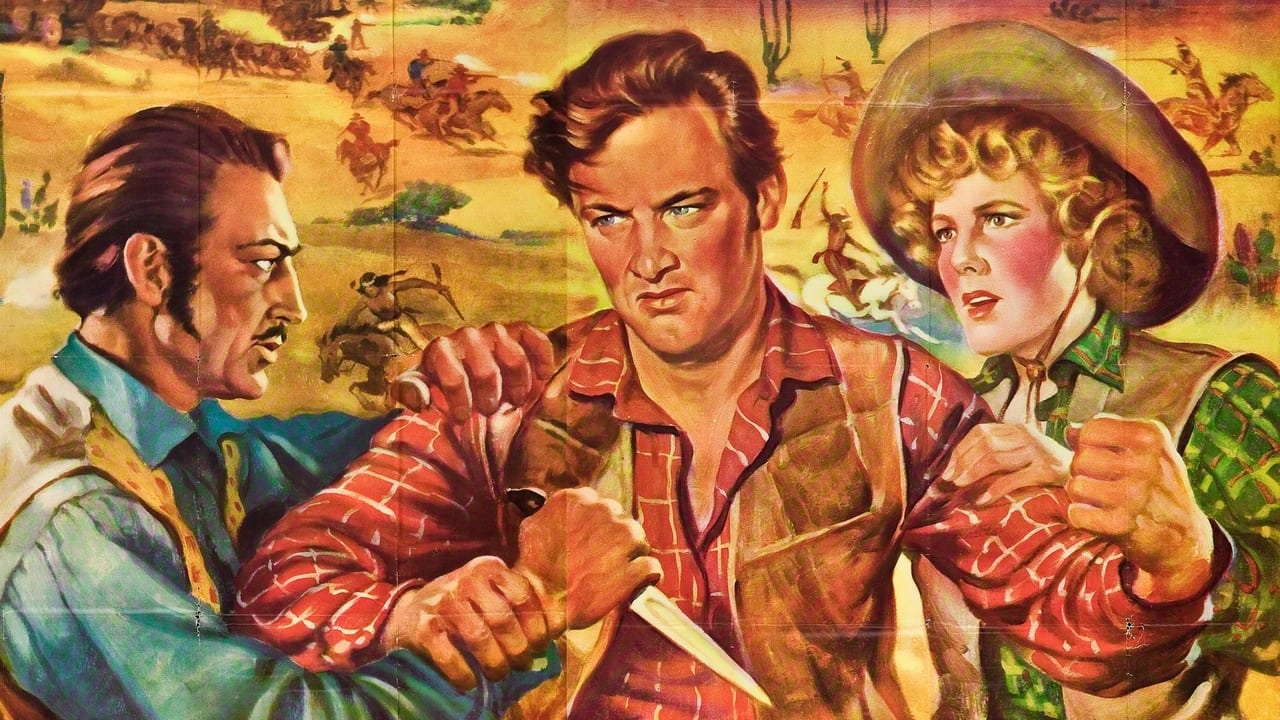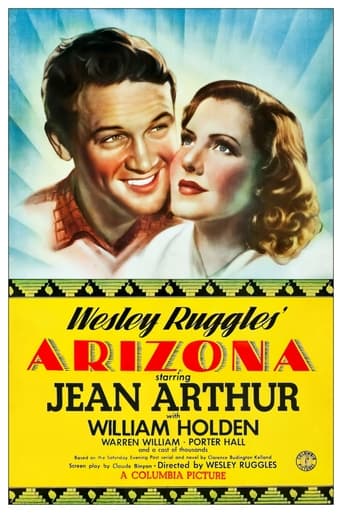

Some things I liked some I did not.
... View MoreBad Acting and worse Bad Screenplay
... View MoreNot sure how, but this is easily one of the best movies all summer. Multiple levels of funny, never takes itself seriously, super colorful, and creative.
... View MoreThe story, direction, characters, and writing/dialogue is akin to taking a tranquilizer shot to the neck, but everything else was so well done.
... View More"Arizona" probably marks the most unusual performance by Jean Arthur. Usually, this actress is known for comedies or romance but here she's in a western. This isn't that unusual, considering she's known for her performance in "Shane". However, here in "Arizona", she plays a completely different sort of role. She's a tough-as-nails broad--one who is the equal to any man....and don't you forget it!!The film begins in Tucson, Arizona about 1861. It's a wild town--and not even much of a town at that. The only non-Indian or Hispanic woman there is Phoebe (Arthur) and you are introduced to her when she enters the cantina and holds all of men working for Lazarus Ward (Porter Hall) at gunpoint! It seems some of them stole from her and she's going to blow their heads off unless they return the money! Watching all this is a newcomer, Peter (William Holden) and, bizarrely, he's smitten!! She soon falls for him, too. However, there's a glitch in their romance-- he's a wandering soul and is only stopping by on his way to California. When he eventually leaves town, it leaves Phoebe to deal not only with the skunk Ward but his secret partner, Jefferson Carteret (Warren William). The two weasels plan on ruining Phoebe's budding freight business and when that attempt fails, Carteret plans on something even more devious. When Peter returns from California, he sees right through Carteret and you know by the end of the film one of them will be pushing up daisies!This is a rather sprawling film with a little bit of everything in it. While the film isn't easy to believe, the acting is quite nice. I particularly liked William--who was magnificent in playing slimy rogues. And, here he's at his slimiest! Well worth seeing if a bit silly in places--it's the sort of western that's fun to watch but difficult to believe. Plus, too often the film relied on intertitle cards scattered throughout the film instead of actually SHOWING things they should have shown instead. Good but not great overall.
... View MoreI am a fan of all 3 of this film's principals - Jean Arthur, William Holden and Warren William. This film is not the premier vehicle for any of their talents, however, it is a very entertaining western. First, if you have read some of the other comments, I want to provide a few corrections. William Holden is NOT a drifter - he is in the United States Cavalry. He does not appear and disappear. Early in the film he returns rather expediently (just like the Cavalry!) to save Jean Arthur when Porter Hall has turned the tables on her (so to speak) and has her at gunpoint. Holden then pops in and out of Arthur's office a time or two, while stationed in Tucson. (Presumably he is on duty from time to time!) Jean Arthur does not become feminine whenever Holden is around. To the contrary, she is in her usual, untidy, "male" garb whenever he is around - even when he proposes to her! The first time she dons a dress is on the eve of Holden's trip back to Nebraska to acquire feedstock for the ranch they are building - which is the reason he "disappears!" The dress, she makes clear, is new for the occasion - intended to remind him of what's waiting for his return! (It may well be her only dress - "special" for the occasion, and in anticipation of her married life!) She rides out to meet him with their new herd in her same- old breeches and hat! Oh yeah - she wears a dress on their wedding day!Many negative comments have been made about the difference in age between Arthur and Holden. Actually, I completely disagree with the criticism - on several levels. First, from a technical standpoint, I find it fascinating that in this film the customary casting technique is reversed! Male leads are usually old enough to be the fathers of their co-stars! But when I look at Arthur in this movie, I fail to see a woman who is obviously older than Holden. I think Jean Arthur's age is always difficult to determine in film - if you are inclined to speculate on such matters. She seems rather ageless to me - and she certainly doesn't "show her age" in this movie. Even more to the point, however, I suspect that people who criticize the film on that basis are more influenced by other depictions by Hollywood of the Old West than by the reality, itself. Women lived extremely hard lives in the Old West. Plus, I have no doubt that the climate of Territorial Arizona would have rapidly aged a hard-working woman. Without modern moisturizers and astringents, I suspect a woman's skin began to look twice its age after a very short time in that harsh environment. Thus, if you do think that Arthur looks older than (an admittedly very young-looking) Bill Holden, I suspect that's just about what you should expect of a female in that environment when compared with a recent arrival from less harsh environs further east. (For a perfect illustration of this, just check out Barbara Stanwyck in So Big. The use of hands as a symbol in that movie is wonderful!)The story is a little uneven. Just how the arrival of the herd on the very day Arthur is to pay off the debt will help her circumstances is not made clear. No prospective buyer is ever identified. Nor has Warren shown any willingness to accept cattle in payment. AND, After all, the herd was intended to be the basis of their ranch stock. But never mind! The cast is stellar. Warren William stands out as the villain. Holden is good in his first starring role. Arthur always looks and sounds good, even if she seems a little out of place in dusty Tucson - as opposed to an office on Capitol HIll! This is not a great western, but it is a good example of a TYPICAL western. THAT is its strength.
... View MoreAt the risk of sounding jingoistic, this film shows in microcosm how the greatest nation the world has ever known, the United States of America, came into being. It was literally carved from the wilderness by brave frontier men and women who are played as archetypes of those heroes and heroines by screen legends William Holden (one of my favorites) and Jean Arthur (Mr. Deeds, Only Angels Have Wings, The Talk of the Town). The very precarious existence of America's pioneers is presented with stark realism in this entirely plausible film. For those who only celebrate the Fourth of July by enjoying the fireworks, let them understand the hardships (and triumphs) their ancestors faced . Terrific period drama. 7/10.
... View MoreThe story line in this film is basically fictional, but real names of people who lived in Tucson, Arizona Territory, in the late nineteenth century are given to members of the cast, and the set that was created specifically for its production still exists just over the hill from the real Tucson of today. As someone who remembers visiting that set during filming in 1940, I am still impressed by the place and by this film. Jean Arthur's character was indeed a prototype of the independent frontierswoman . But even more important from the perspective of today as I stand among the remnants of the old set (still used, together with a sound stage on the property, to produce "Westerns") and look back sixty years just as the producers looked back sixty years for their story, I think of it as a story within a story. Anyone visiting Arizona today would do well to think of the film "Arizona" as a true picture of 1880 and, in another context, of 1940, and let their imaginations wander. The social attitudes and mores of both periods stand in great contrast to those of the 21st century.
... View More